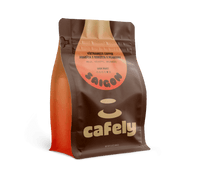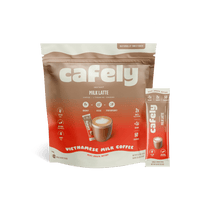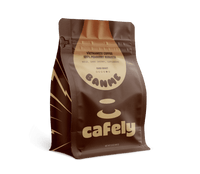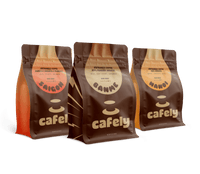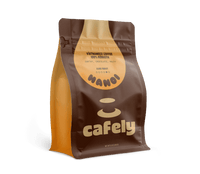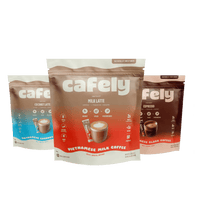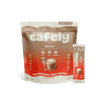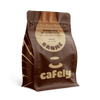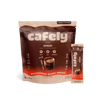Picture this: you pour your morning coffee just like normal — then stir in a slab of butter or MCT oil.
Weird? Maybe. Effective? Absolutely.
This trend, called butter coffee (or bulletproof coffee), is popular for a reason. Advocates swear it delivers lasting energy, sharper focus, and better appetite control — especially for those on low-carb or keto diets.
But is it just a fad, or is there real science behind it?
In this guide, we’ll break down where it came from, what it does, and whether it’s worth a try.
1. It Gives You Steady, Long-Lasting Energy
Regular coffee gives you a quick jolt of energy. But if you drink it on an empty stomach, that buzz can crash fast — and leave you feeling shaky or hungry.
When you add butter, you’re giving your body healthy fats that take longer to break down. This means your energy levels rise more smoothly and stick around longer. No more crash an hour later.
Butter has saturated fats, which slow digestion just enough to stretch out your caffeine boost.
Think of it like putting a slow-burning log on your fire instead of just paper.
Suggested: Best Coffee for Energy
2. It Helps Sharpen Focus & Clear the Brain Fog
Your brain loves fat. In fact, it needs it.
The fats in butter — especially when paired with MCTs (medium-chain triglycerides) from coconut oil — give your brain quick fuel without a spike in blood sugar. That’s why many people say butter coffee helps them feel more clear-headed and alert.
Some studies suggest MCTs may help with mental clarity and even support memory [1]. But even without the science, lots of people report feeling more focused after their cup of buttery brew.
3. It Makes Coffee Creamier (& Kind of Fancy)

Let’s be honest — plain black coffee can be bitter and thin. Adding butter gives it a smooth, rich texture that feels almost like a latte without any sugar or lactose.
It blends into the coffee (especially if you use a blender or frother) and creates a foamy top layer that’s seriously satisfying.
For people on low-carb or keto diets who skip milk or cream, this is a game-changer.
Suggested: What is Coffee Creamer?
Where Did Butter in Coffee Come from? A Look at Its Origins
Adding butter to hot drinks isn't new. In fact, people have been doing this for centuries — across the globe.
Let’s take a quick trip through the history of buttered beverages.
Tibetan Yak Butter Tea
Long before butter hit coffee mugs in the West, Tibetans were mixing yak butter with tea.
It’s called Po Cha — a traditional drink made with black tea, yak butter, and salt. Locals drink it daily to stay warm and energized in high altitudes.
It’s not just about taste. The fats help with endurance, especially in tough climates. And that same idea — fat as fuel — is part of what inspired the butter coffee movement today.
Bulletproof Coffee & the Modern Comeback
The term Bulletproof Coffee came from entrepreneur Dave Asprey, who visited Tibet, tried the local butter tea, and came back with an idea.
In 2009, he created a version using coffee, grass-fed butter, and MCT oil. He claimed it helped him feel more energized, full, and focused.
Soon, health bloggers, fitness fans, and keto dieters were trying it out — and loving it.
While Asprey suggests using specific ingredients (like mold-free beans and refined MCT oil), many people make their own at home using regular coffee, unsalted butter, and a splash of coconut oil.
Suggested: What Is Keto Coffee?
Other Cultural Variations
Tibet wasn’t the only place where fat met caffeine.
In Singapore, a drink called nanyang kopi became popular in the 1930s. It was cheap, filling, and perfect for busy factory workers.
Here’s how they made it:
- Start with sweetened condensed milk in a cup.
- Add a strong coffee concentrate.
- Top it off with a slice of unsalted butter.
The butter floats to the top and melts slightly, giving the coffee a thick, creamy body — kind of like a no-fuss latte.
Some even say butter was added to Ethiopian coffee as early as the 9th century, though that version looked very different from today’s brews.
What Are the Health Benefits of Butter Coffee?

Butter coffee isn’t just about rich taste or creamy texture. For many, it’s also about how it makes them feel. From supporting popular diets to keeping hunger at bay, butter coffee has carved a niche in the wellness world.
Let’s explore some of the key health claims and what science says about them — in plain language.
1. Supports Keto & Low-Carb Diets
If you’re following a keto or low-carb lifestyle, butter coffee fits right in. It’s made almost entirely of fat and has virtually zero carbs (~0.01g/tbsp), making it perfect for staying in ketosis — the fat-burning state your body enters when you eat low carb.
The fats in butter coffee, especially when made with MCT oil, are turned into ketones, which your body can use for quick energy. This helps reduce reliance on sugar or carbs for fuel, which is what keto diets aim for.
Just remember: While butter coffee can give you a boost, it won’t magically get you into ketosis unless your whole diet is aligned.
2. Helps Control Hunger
One big reason people love butter coffee? It makes them feel full.
Thanks to the healthy fats, especially MCTs found in coconut oil, butter coffee can slow digestion and reduce cravings. In one study, people who added MCT oil to their breakfast ate 220 fewer calories at lunch [2].
This effect may not last forever — research shows it can wear off over time [3,4]. But in the short term, it might help you eat less, especially if you’re skipping breakfast or doing intermittent fasting [5,6,7].
Want to try it while fasting? Make sure you're also staying hydrated and eating balanced meals later in the day.
3. Packed With Healthy Fats
Butter coffee contains mostly saturated fats — which get a lot of mixed press. But if you’re using grass-fed butter, you’ll also get some good stuff:
- Omega-3s (good for brain and heart)
- Vitamin A (helps your skin, eyes, and immune system) [8]
- Vitamin K2 (helps your body use calcium better)
One cup of butter coffee can have 50 grams of fat and 445 calories. If you’re not on a high-fat diet like keto, this might be a lot for your body to handle every day.
Tip: Try balancing out the rest of your day with meals that are lighter in fat and richer in fruits, veggies, and lean proteins.
How to Make Butter Coffee: A Simple Guide
Making butter coffee at home is surprisingly easy — and you don’t need any fancy gear or branded ingredients.
Here's a simple step-by-step method with tips to make it even better.
The Basic Recipe
You’ll need:
- 1 cup (8–12 oz) of brewed black coffee
- 1–2 tablespoons of unsalted, grass-fed butter (or ghee)
- 1–2 tablespoons of MCT oil or coconut oil
Blend for 20–30 seconds until the mixture looks creamy and frothy, like a latte.
Check out this butter coffee recipe for extra flavor tips and brewing suggestions.
Why Blending Matters
Simply stirring in butter won’t give you that rich, velvety texture. The fats will float and separate, leaving an oily layer on top. Blending emulsifies the fat and coffee — turning it smooth, thick, and slightly foamy.
You can use:
- A blender
- A handheld milk frother
- A stick (immersion) blender
Pro tip: Blending also helps your stomach digest it better.
Customize the Flavor
Here’s where it gets fun. Try adding one or more of the following:
- A pinch of cinnamon
- A drop of vanilla extract
- A dash of unsweetened cocoa powder
- A sprinkle of nutmeg or cardamom
You can even add a scoop of collagen powder or protein if you’re replacing breakfast.
Suggested: Make a Banana Coffee Smoothie
Is Butter Coffee Right for You? Things to Consider

Butter coffee isn’t for everyone — and that’s okay. Before making it a daily habit, think about your personal needs and health goals.
High-Calorie Content
If you’re trying to lose weight by cutting calories, be careful. One cup can have nearly half your daily fat allowance, especially if you’re not following a high-fat diet.
Instead, consider pairing a smaller cup with a light, protein-rich breakfast.
Lactose Sensitivity
Butter contains small amounts of lactose. If you’re sensitive or allergic, try ghee — it’s a form of clarified butter that removes most lactose and milk solids.
It tastes buttery but is gentler on your gut.
Medical Conditions or Concerns
Have high cholesterol? Digestive issues? A family history of heart disease?
Talk to your doctor before trying butter coffee regularly.
Research is still mixed on how saturated fats affect long-term heart health. While some studies say it doesn’t increase heart disease risk directly [9, 10, 11], others advise limiting saturated fat and swapping in polyunsaturated fats like those in nuts, seeds, and fish [12].
Balance is key.
Final Thoughts: Butter Coffee, Your Way
Butter coffee isn’t magic — but it can be a handy tool for certain lifestyles. If you're doing keto, fasting, or looking for a creamy, satisfying start to the day, it's worth trying.
Just be mindful of how it fits into your overall diet, especially when it comes to fat intake.
Looking to experiment with different brew methods? Take a look at these guides on everything from the moka pot to the Vietnamese phin drip, AeroPress brewer, and Hario V60. Pair any of them with butter for a bold upgrade.
FAQs: Why Do People Put Butter in Their Coffee?
Got more questions about butter coffee? Here are quick answers to the most common ones.
1. Is it Bad to Put Butter in Coffee While Fasting?
Technically, butter can break a fast — but many intermittent fasters use it during ‘fat fasts’ or keto-style fasting to remain in ketosis while curbing hunger.
What butter coffee is not suitable for is if you're fasting for autophagy or insulin sensitivity.
Suggested: Does Coffee Break a Fast?
2. What is Added to Coffee That Burns Fat?
MCT oil and butter are commonly added to promote fat-burning by boosting ketone production and prolonging energy.
3. What are the Side Effects of Butter Coffee?
It can be high in calories and fat, which may cause digestive discomfort or weight gain if consumed too often.
4. How Much Butter Should You Put in Your Coffee?
Most people add 1–2 tablespoons of unsalted, grass-fed butter per cup of coffee.
5. What is in Bulletproof Coffee?
Bulletproof coffee is made with brewed coffee, unsalted butter, and MCT oil blended until creamy.
6. Is Butter in Coffee Better Than Milk?
For keto or low-carb diets, yes — butter adds fat without carbs and supports ketosis, while milk adds sugar.
7. What Kind of Butter to Use in Coffee?
Use grass-fed, unsalted butter for the best flavor and added nutrients like omega-3s and vitamin A.
8. What is the Coffee Method for Weight Loss?
Butter coffee paired with intermittent fasting may help reduce appetite and promote fat-burning for some people.
9. What Cultures Put Salt in Coffee?
Scandinavian and Turkish cultures have long-standing traditions of adding salt to coffee for flavor and balance.
10. What Can I Add to Butter Coffee for Extra Flavor?
Try cinnamon, vanilla extract, or a dash of cocoa powder for a flavorful twist without added sugar.
References
- Juby, A. G., Blackburn, T. E., & Mager, D. R. (2022). Use of medium chain triglyceride (MCT) oil in subjects with Alzheimer’s disease: A randomized, double‐blind, placebo‐controlled, crossover study, with an open‐label extension. Alzheimer’s & Dementia: Translational Research & Clinical Interventions, 8(1).
- St-Onge, M.-P., Ross, R., Parsons, W. D., & Jones, P. J. H. (2003). Medium-Chain Triglycerides Increase Energy Expenditure and Decrease Adiposity in Overweight Men. Obesity Research, 11(3), 395–402.
- Krotkiewski, M. (2001). Value of VLCD supplementation with medium chain triglycerides. International Journal of Obesity, 25(9), 1393–1400.
- St-Onge, M-P., Bourque, C., Jones, P. J. H., Ross, R., & Parsons, W. E. (2003). Medium- versus long-chain triglycerides for 27 days increases fat oxidation and energy expenditure without resulting in changes in body composition in overweight women. International Journal of Obesity, 27(1), 95–102.
- Maljaars, J., Romeyn, E. A., Haddeman, E., Peters, H. P., & Masclee, A. A. (2009). Effect of fat saturation on satiety, hormone release, and food intake. The American Journal of Clinical Nutrition, 89(4), 1019–1024.
- Carreiro, A. L., Dhillon, J., Gordon, S., Higgins, K. A., Jacobs, A. G., McArthur, B. M., Redan, B. W., Rivera, R. L., Schmidt, L. R., & Mattes, R. D. (2016). The Macronutrients, Appetite, and Energy Intake. Annual Review of Nutrition, 36(1), 73–103.
- Marciani, L., Cox, E. F., Pritchard, S. E., Major, G., Hoad, C. L., Mellows, M., Hussein, M. O., Costigan, C., Fox, M., Gowland, P. A., & Spiller, R. C. (2015). Additive effects of gastric volumes and macronutrient composition on the sensation of postprandial fullness in humans. European Journal of Clinical Nutrition, 69(3), 380–384.
- Chea, E. P., & Milstein, H. (2020). Vitamin A. PubMed; StatPearls Publishing.
- Siri-Tarino, P. W., Sun, Q., Hu, F. B., & Krauss, R. M. (2010). Meta-analysis of prospective cohort studies evaluating the association of saturated fat with cardiovascular disease. The American Journal of Clinical Nutrition, 91(3), 535–546.
- Temple, N. (2018). Fat, Sugar, Whole Grains and Heart Disease: 50 Years of Confusion. Nutrients, 10(1), 39.
- de Souza, R. J., Mente, A., Maroleanu, A., Cozma, A. I., Ha, V., Kishibe, T., Uleryk, E., Budylowski, P., Schünemann, H., Beyene, J., & Anand, S. S. (2015). Intake of saturated and trans unsaturated fatty acids and risk of all cause mortality, cardiovascular disease, and type 2 diabetes: systematic review and meta-analysis of observational studies. BMJ, 351(1), h3978.
- Hooper, L., Martin, N., Abdelhamid, A., & Davey Smith, G. (2015). Reduction in saturated fat intake for cardiovascular disease. Cochrane Database of Systematic Reviews, 8(6).
